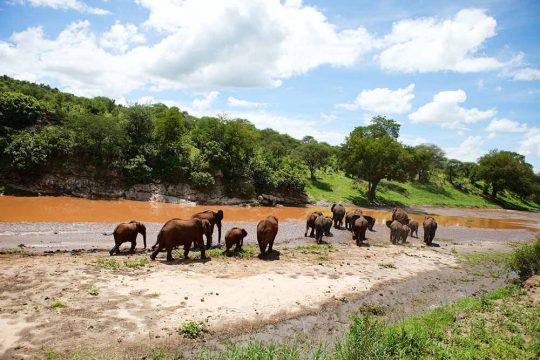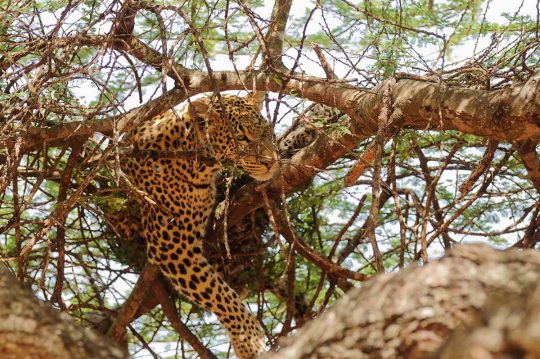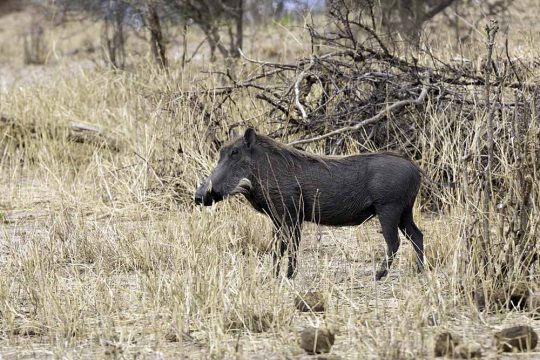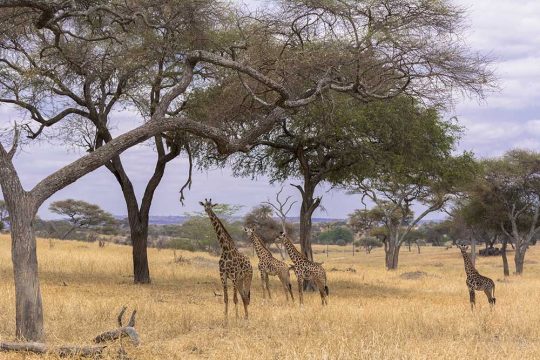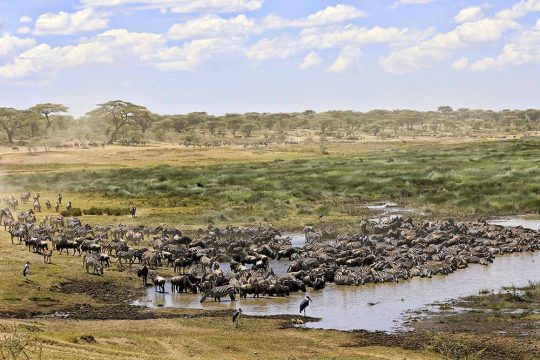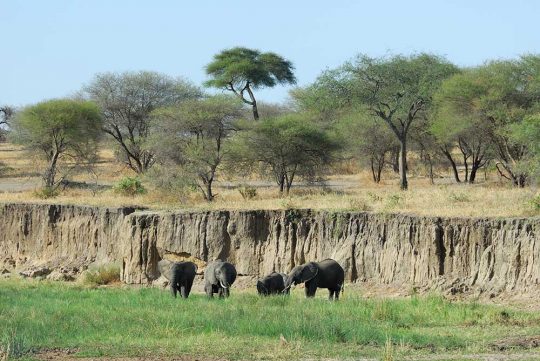Tarangire National Park
Are you thinking to go on safari in Tarangire?
Talk to our experts about the perfect planning for your holiday.
Error: Contact form not found.
- About Tarangire
- Interesting facts about Tarangire
- Best Time to Visit Tarangire
- Getting to Tarangire
- Things to see in Tarangire
- Things to do in Tarangire
- Where to Stay in Tarangire
- Weather & Climate
Lies slightly off the main northern Tanzania safari route, Tarangire National Park is an adorable and Fantastic Park to visit.
About Tarangire National Park
Reputed for its highest concentration of elephants, buffalos, birding, and authentic safari atmosphere, the park has a lot to offer.
Tarangire is the 7th largest National park of Tanzania behind Nyerere, Ruaha, Serengeti, Mikumi, Katavi, and Mkomazi National parks. Tarangire is often referred to as small Serengeti due to its superb cat life.
Tarangire River
Tarangire River which runs from north to south acts as the main source of life during the dry season and the name of this reputable park originates from the Tarangire River.
The presence of this river is of paramount importance especially during the dry season as it attracts many predators who remain around the river surroundings to ensure themselves with a water supply and the majority of prey who comes to drink water. Apart from the main Tarangire River, the park has several water sources which also act as good wildlife viewing points.
The park has a game viewing area that is about ten times the size of its neighbor park the Lake Manyara National park. The concentration of games from July to October is so exceptional in the Tanzania Northern Safari circuit. During these seasons of the year, Tarangire offers an exceptional atmosphere and habitats which are quite different from the other parks. With its wide area, visitors can relish their safari experiences through the quietest game viewing opportunities.
Famous For:
The herds of elephants up to 3,000
Interesting Facts About Tarangire National Park
Tarangire River & Baobab Trees
- Leopards and pythons also like to lounge in the branches of the sausage tree and other species in the park.
- Tarangire River flows through the park and becomes the only water source for thousands of migrating animals in the dry season.
- Baobab trees, common in Tarangire National Park, can grow to have trunks reaching more than 100 feet in circumference. One of these trees was once found that proved to be 1275 years old, although not in this park.
Termite mounds & Wildlife
- Termite mounds are often seen in the park. Dwarf mongooses make use of the termite mounds once the termites have abandoned them.
- Wildlife found in Tarangire National Park includes lions, leopards, cheetahs, various primates, ostriches, flamingoes, elephants, rhinos, giraffes, zebras, gazelles, buffaloes, wildebeests, pythons, hartebeests, elands, and impalas.
Elephants of Tarangire
- Tarangire National Park is believed to have the largest elephant concentration in the world. After Serengeti National Park has the second-highest wildlife concentration in Tanzania.
- Elephant herds in Tarangire National Park often reach 300 or higher in terms of population numbers.
White Giraffe & Birds
- Some of the more interesting birds that can be found in Tarangire National park include the Yellow-collared lovebirds, the Kori bustard (the heaviest flying species of bird), and the largest bird – the stocking-thighed ostrich, and hornbills.
- A white giraffe was spotted in Tarangire National Park in 2015. The white color is due to leucism – partial loss of pigmentation.
Best Time to Visit
June to October (Animals congregate around the Tarangire River)
The game viewing opportunities from June to October (dry season) are exceptional but for the rest of the year, the majority of the games are probably out of the park, either onto the floor of the Rift Valley or to the grazing grounds. Hence, in off-season months there are few expectations on high concentrations of games, but for those who want to avoid the crowds, we would recommend them to travel during off-season months.
High Season
June to October (The Park is full of tourists.)
Low Season
April and May (Rates might be lower).
Getting There
Tarangire National Park is among the most popular destinations for day tours and game drive safaris. The park can be reached by road or flight depending on your safari preferences. Although flights to the park are commonly less used as the journey to the park can take only about a 2 hours drive from Arusha City which is the starting point of all Northern Tanzania Safaris.
Two airways lead you to Tanzania & Tarangire:
Kilimanjaro International Airport (JRO)
Julius Nyerere International Airport (JNIA)
However, for your safari goals, Kilimanjaro International Airport serves you the best.
Kilimanjaro International Airport (JRO)
Kilimanjaro International Airport (JRO) is situated 46km/29mi east of Arusha, the gateway of Tanzania’s most popular Northern safari circuit including Tarangire.
From Arusha, it is a scenic 3 hours drive to Tarangire national park.
Julius Nyerere International Airport (DAR)
Tanzania’s main airport is Julius Nyerere International Airport (DAR) located 13km/8mi southwest of Dar es Salaam. This is the entry-point for visitors to the southern parks (Mikumi, Selous, Ruaha national parks).
Moving on from Dar es Salaam to Arusha you can fly or drive. However, a drive will take 10-12 hours via public transport. You can also get a transfer from Dar es Salaam to Arusha via private vehicle, however…this is expensive.
There’re local flights from Dar es Salaam to Arusha which land at JRO Airport or Arusha Airport.
We usually advise guests to minimize unnecessary costs by flying to Kilimanjaro International Airport. The only exception for this is when someone has to go to Dar es Salaam first for various areas.
Things to See in Tarangire National Park
Tarangire Wildlife
During the dry months, the concentration of animals around the Tarangire River is almost very high. The ecosystem of the park is balanced by a migration pattern that is followed by the majority of games in the park. Elephants are the main attraction in Tarangire, with up to 3,000 during the peak season.
In the Peak months, you will also see a good number of animals such as wildebeest, zebra, giraffe, buffalo, Thompson’s gazelle, greater and lesser kudu, eland, dwarf Mongoose, spotted hyena, leopard, and cheetah.
Visitors can see colonies of medieval baobab trees, these incredible trees that are more than 100 years old.
Birding Paradise
Tarangire is one of Tanzania’s finest birding destinations, hence you will have a chance to spot as many bird species as possible.
The park is among the most birds’ concentrated destinations in the country. With more than 500 species of birds recorded currently, the park is truly a perfect birding destination.
The presence of a good number of water sources attracts hundreds of birds such as colorful Yellow-collared lovebirds, flamingos, the Kori bustard, hornbills, and many more, hence making the park an ideal birding destination for bird watchers.
Things to Do
When comes to things to do in Tarangire, the park has a lot of attractions to explore. You can go on guided walking safaris, game drives, and cultural visits to neighboring villages. Tarangire is also among a very few destinations that give you the opportunity for a night game drive.
Generally, Tarangire is the best destination where you can visit and explore;
- Magnificent wildlife viewing
- High concentration of elephants in the park
- Excellent birding experiences that you can find nowhere else.
- Impressive scenery formed by uncountable baobab and acacia trees
Weather & Climate
Tarangire has a bimodal rainfall averaging 650 mm per annum
Short rains are from November to February
Long rains are from March to May
The rains, particularly the short rains, are very unreliable and often fail.
The dry season is from June to October
If you liked Tarangire National Park, you might also like Lake Manyara National Park.
For more content like this, please follow us on Instagram.
Do you need expert tips on planning for your next safari in Africa?
Share your email here
[mc4wp_form id=”29279″]

